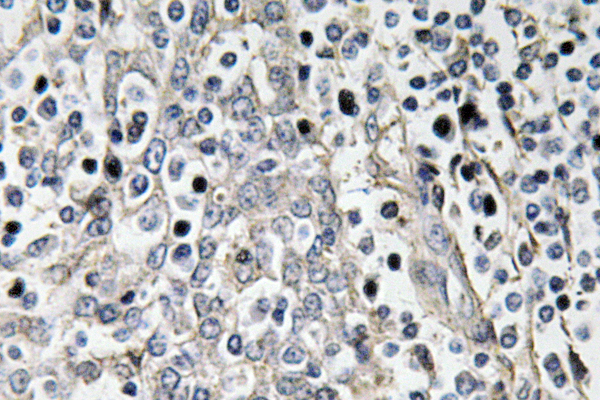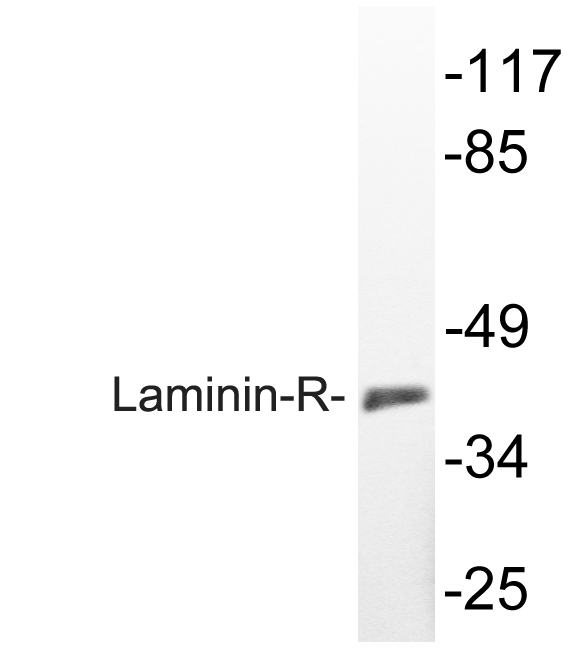Laminin-R Polyclonal Antibody
- Catalog No.:YT2533
- Applications:WB;IHC;IF;ELISA
- Reactivity:Human;Mouse;Rat
- Target:
- Laminin-R
- Fields:
- >>Ribosome;>>Coronavirus disease - COVID-19
- Gene Name:
- RPSA
- Protein Name:
- 40S ribosomal protein SA
- Human Gene Id:
- 3921
- Human Swiss Prot No:
- P08865
- Mouse Gene Id:
- 1.00505e+008
- Mouse Swiss Prot No:
- P14206
- Rat Gene Id:
- 29236
- Rat Swiss Prot No:
- P38983
- Immunogen:
- The antiserum was produced against synthesized peptide derived from human Laminin-R. AA range:166-215
- Specificity:
- Laminin-R Polyclonal Antibody detects endogenous levels of Laminin-R protein.
- Formulation:
- Liquid in PBS containing 50% glycerol, 0.5% BSA and 0.02% sodium azide.
- Source:
- Polyclonal, Rabbit,IgG
- Dilution:
- WB 1:500 - 1:2000. IHC 1:100 - 1:300. ELISA: 1:40000.. IF 1:50-200
- Purification:
- The antibody was affinity-purified from rabbit antiserum by affinity-chromatography using epitope-specific immunogen.
- Concentration:
- 1 mg/ml
- Storage Stability:
- -15°C to -25°C/1 year(Do not lower than -25°C)
- Other Name:
- RPSA;LAMBR;LAMR1;40S ribosomal protein SA;37 kDa laminin receptor precursor;37LRP;37/67 kDa laminin receptor;LRP/LR;67 kDa laminin receptor;67LR;Colon carcinoma laminin-binding protein;Laminin receptor 1;LamR;Laminin-binding pr
- Observed Band(KD):
- 43kD
- Background:
- Laminins, a family of extracellular matrix glycoproteins, are the major noncollagenous constituent of basement membranes. They have been implicated in a wide variety of biological processes including cell adhesion, differentiation, migration, signaling, neurite outgrowth and metastasis. Many of the effects of laminin are mediated through interactions with cell surface receptors. These receptors include members of the integrin family, as well as non-integrin laminin-binding proteins. This gene encodes a high-affinity, non-integrin family, laminin receptor 1. This receptor has been variously called 67 kD laminin receptor, 37 kD laminin receptor precursor (37LRP) and p40 ribosome-associated protein. The amino acid sequence of laminin receptor 1 is highly conserved through evolution, suggesting a key biological function. It has been observed that the level of the laminin receptor transcript is higher in
- Function:
- function:Required for the assembly and/or stability of the 40S ribosomal subunit. Required for the processing of the 20S rRNA-precursor to mature 18S rRNA in a late step of the maturation of 40S ribosomal subunits. Also functions as a cell surface receptor for laminin. Plays a role in cell adhesion to the basement membrane and in the consequent activation of signaling transduction pathways. May play a role in cell fate determination and tissue morphogenesis. Also acts as a receptor for several other ligands, including the pathogenic prion protein, viruses, and bacteria.,miscellaneous:It is thought that in vertebrates 37/67 kDa laminin receptor acquired a dual function during evolution. It developed from the ribosomal protein SA, playing an essential role in the protein biosynthesis lacking any laminin binding activity, to a cell surface receptor with laminin binding activity.,miscellaneo
- Subcellular Location:
- Cell membrane. Cytoplasm. Nucleus . 67LR is found at the surface of the plasma membrane, with its C-terminal laminin-binding domain accessible to extracellular ligands. 37LRP is found at the cell surface, in the cytoplasm and in the nucleus (By similarity). Colocalizes with PPP1R16B in the cell membrane. .
- Expression:
- B-cell lymphoma,Blood,Bone marrow,Brain,Cajal-Retzius cell,Cervix,Fetal brain corte
- June 19-2018
- WESTERN IMMUNOBLOTTING PROTOCOL
- June 19-2018
- IMMUNOHISTOCHEMISTRY-PARAFFIN PROTOCOL
- June 19-2018
- IMMUNOFLUORESCENCE PROTOCOL
- September 08-2020
- FLOW-CYTOMEYRT-PROTOCOL
- May 20-2022
- Cell-Based ELISA│解您多样本WB检测之困扰
- July 13-2018
- CELL-BASED-ELISA-PROTOCOL-FOR-ACETYL-PROTEIN
- July 13-2018
- CELL-BASED-ELISA-PROTOCOL-FOR-PHOSPHO-PROTEIN
- July 13-2018
- Antibody-FAQs
- Products Images

- Immunohistochemistry analysis of Laminin-R antibody in paraffin-embedded human tonsil tissue.

- Western blot analysis of lysate from K562 cells, using Laminin-R antibody.



